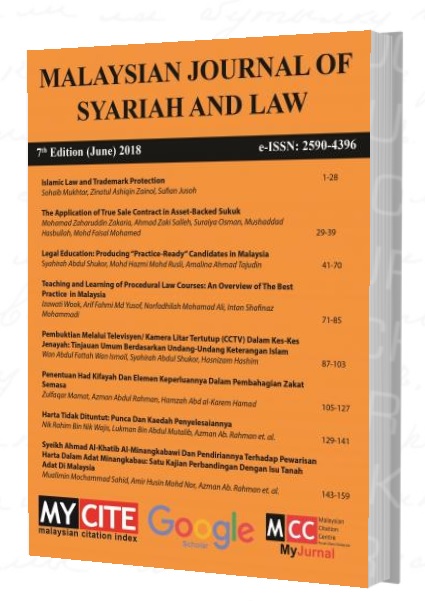LEGAL EDUCATION: PRODUCING "PRACTICE-READY" CANDIDATES IN MALAYSIA
DOI:
https://doi.org/10.33102/mjsl.vol6no1.82Keywords:
legal education, academia, common bar examAbstract
Despite the existing exam requirements in a bachelor of law degree, it is claimed that local law graduates are ill-prepared for legal practice, lack of fluency in English, particularly in writing and speaking skills. This paper explores efforts made by the law schools in Malaysia within their existing curriculum to prepare students for future legal practice careers and to cater to the needs of the legal industry. The requirement of a recognized law degree has been fulfilled by most law schools, and students studying in law schools without recognition by the Legal Profession Qualifying Board (LPQB) would have to sit for Certificate of Legal Practice (CLP) to qualify as a practitioner. Nevertheless, the Bar Council has been proposing for additional curriculum of Common Bar Course and Common Bar Exam. It is claimed that these additional stage of common bar course and exam would be beneficial for candidates alongside their somewhat “inefficient†bachelor of law degree. Sitting for this bar exam would allow candidates to qualify as “qualified person†under the law. Nevertheless, this paper holds on to the view that training in chambers or the pupillage period, would be the best place platform for law graduates to equip themselves with hands-on experience in legal practice, and that the “higher-standard†of paper-based exams proposed by the Bar would be futile in keeping up with the expectations of the legal industry for “practice-ready†candidates.
(Key words: legal education; academia; common bar exam)
Downloads
References
Azzat, F. (2006). CLP Exam Should be Scrapped. from http://www.malaysianbar.org.my/members_opinions_and_comments/opinion_clp_exam_should_be_scrapped.html
Basedow, J. (2014). Breeding lawyers for the global village: The Internationalisation of law and legal education In W. v. Caenegem & M. Hiscock (Eds.), The Internationalisation of Legal Education: The Future Practice of Law: Edward Elgar Publishing Limited.
Bui, N.S. (2016). Legal Education in 21st Century Vietnam: From Imitation to Renovation.
Cheah, R. (2008). CLP to be scrapped, says Zaid. Retrieved May 22, 2015 from http://www.thestar.com.my/story/?file=%2f2008%2f5%2f14%2fnation%2f20080514141117&sec=nation
Chen, S. (2015, November). International Moot Court as Equaliser: An Asian Paradigm. Paper presented at the ASLI Symposium : Legal Education in Asia: From Imitation to Innovation, Shanghai Jiao Tong University, China.
Chesterman, S. (2015, November). The Fall and Rise of Legal Education in Asia: Inhibition, Imitation and Innovation. Paper presented at the ASLI Symposium : Legal Education in Asia: From Imitation to Innovation, Shanghai Jiao Tong University, China.
Common Bar Exam. (2009). Retreived from
http://www.elawyer.com.my/blog/common-bar-exam/
Grossman, C. (2009). Building the World Community Through Legal Education. In J. Klabbers & M. Sellers (Eds.), The Internationalization of Law and Legal Education: Springer.
Hashim, H.M. (1981) Are the Present Legal Profession Practice & Etiquette Rules Adequate? Current Law Journal, 23.
Hashim, H.M. (1983) Preparation of Law Students for Law Practice [1983] 1 Current Law Journal, 7.
Hu, J., Li, X., and Li Y., (2015, November). Globalisation and Innovative Study: Legal Education in China. Paper presented at the ASLI Symposium : Legal Education in Asia: From Imitation to Innovation, Shanghai Jiao Tong University, China.
Husaini, M.. (2012). Law Degree Programme Still Undergoing Recognition Process. Retrieved from http://www.thestar.com.my/story/?file=%2F2012%2F7%2F26%2Ffocus%2F11730145
Husaini, M.F. and Salleh, K., (2013) “The Paradigm Shift of the Legal Education in Malaysia: A Research on the Global Perspectives, 4th International Conference on New Horizons in Education. Retrieved from www.sciencedirect.com
Katz, M., Facilitating Better Law Teaching-Now.(2013) Emory Law Journal, 62, 823.
King, T. (2015). The Future of Legal Education from the Profession's Viewpoint: A Brave New World. In H. Sommerlad, S. Harris-Short, S. Vaughan & R. Young (Eds.), The Futures of Legal Education and the Legal Profession: Bloomsbury.
Koshy, S. (2013). The Common Bar Examination: Realities of Legal Education in Malaysia. Retrieved from http://www.thestar.com.my/News/Nation/2013/01/20/Uphill-task-to-turn-out-good-lawyers/
Kozuka, S. (2015, November). “Closing the Gap†between the Legal Education and Courtroom Practice in Japan: YôkenJijitsu Teaching and the Role of Judiciary. Paper presented at the ASLI Symposium : Legal Education in Asia: From Imitation to Innovation, Shanghai Jiao Tong University, China.
Legal Profession Act 1976 (Act 166). Retrieved fromhttp://www.lpqb.org.my/index.php?option=com_content&view=article&id=105&Itemid=99
McConnaughay, P.J., and Toomey,C.B., (2015, November). Preparing for the Sinicization of the Western Legal Tradition: The Case of Peking University School of Transnational Law. Paper presented at the ASLI Symposium : Legal Education in Asia: From Imitation to Innovation, Shanghai Jiao Tong University, China.
Maxeiner, J.R. (2009). Integrating Practical Training and Professional Legal Education. In J. Klabbers & M. Sellers (Eds.), The Internationalization of Law and Legal Education: Springer.
Pongsapan, M. (2016). Legal Education in Thailand: Limitation on Innovation. Paper presented at the ASLI Symposium : Legal Education in Asia: From Imitation to Innovation, Shanghai Jiao Tong University, China.
Pupillage. (2002-2008). Retrieved from http://www.malaysianbar.org.my/pupillage.html
Sharom, A. (2008). Of Dilbert and Bulldogs. from http://www.thestar.com.my/Story/?file=%2F2008%2F5%2F29%2Fcolumnists%2Fbravenewworld%2F21374325
Shukor, S.A, Rusli, M.H.M, & Tajudin, A.A. (2015). The Common BAR Examination: Realities of Legal Education in Malaysia. Retrived from http://www.themalaysianinsider.com/sideviews/article/realities-of-legal-education-in-malaysia-syahirah-abdul-shukor-mohd-hazmi-m
Steele, S. & Taylor, K. (2010). Introduction: Globalization, Change and Context. In S. Steele & K. Taylor (Eds.), Legal Education in Asia: Globalization, Change and Context Routledge.
Stolker, Carel. (2014). Rethinking the Law School: Education , Research, Outreach and Governance: Cambridge University Press.
Sulistiawati, L.Y., & Hanif I., Second Fiddle: Why Indonesia’s top graduates shy away from the Judiciary (and the Prosecutor’s Office), and what can we do about it? Paper presented at the ASLI Symposium : Legal Education in Asia: From Imitation to Innovation, Shanghai Jiao Tong University, China.
Tan, Roger. (2011). High Time for a New Bar. from http://www.malaysianbar.org.my/members_opinions_and_comments/high_time_for_a_new_bar.html
The LPQB Portal,. Retrieved from http://www.lpqb.org.my/index.php?option=com_content&view=article&id=318:status-of-the-bachelor-of-laws-hons-programme-at-universiti-sultan-zainal-abidin-kuala-terengganu&catid=1:latest
Thiru, Steven. (2008). Common Bar Course- A Proposed Framework
Thiru, Steven. (2011). A First Class Legal Profession: A Common Bar Course to
Transform the Training of New Entrants to the Malaysian Legal Profession. PRAXIS,Chronicle of the Malaysian Bar, July-Sept 2011.
Wai, W.C. (2015). The Sad State of English in Malaysia. Retrieved from http://www.thejakartapost.com/news/2015/06/22/the-sad-state-english-malaysia.html

Downloads
Published
How to Cite
Issue
Section
License
Copyright (c) 2018 Amalina Ahmad Tajudin

This work is licensed under a Creative Commons Attribution-NonCommercial 4.0 International License.







































